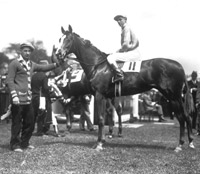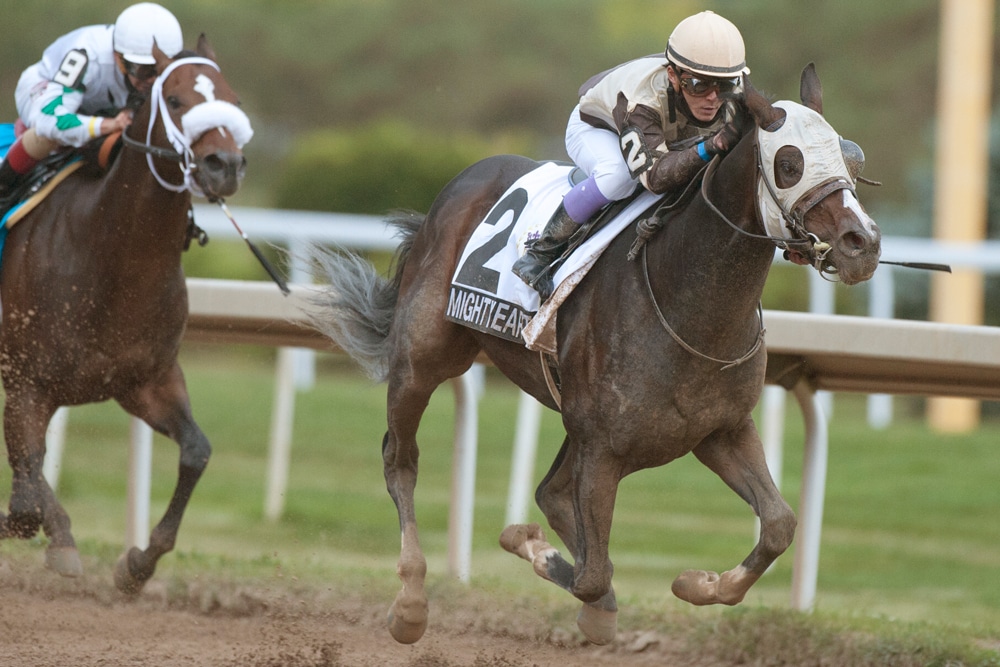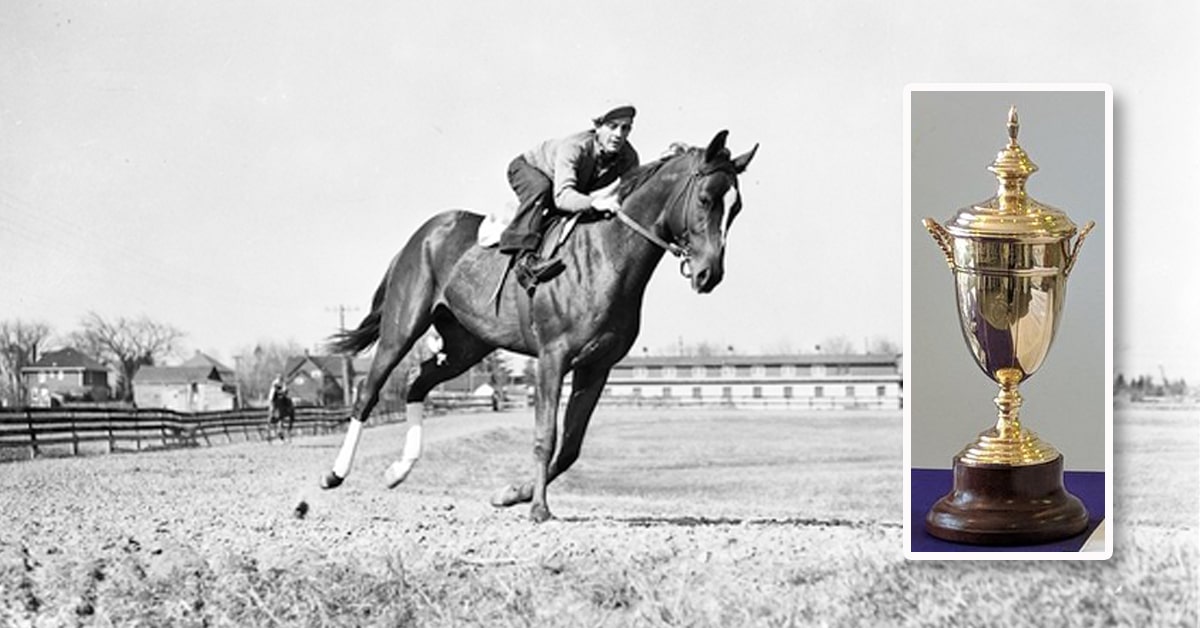The lucrative Prince of Wales Stakes– best known for being the second jewel of the Canadian Triple Crown – has long been a staple of Canadian racing. The race wasn’t always the extravagant affair that it is today.
Originally known as the Prince of Wales Plate – a name the event kept until 1953 – its inaugural running was at the long-gone Thorncliffe Park Raceway in Toronto for a $7,500 purse. In the early 1930s, the purse fell to a mere $2,500 as a result of the Great Depression. The Prince of Wales Stakes was later relocated to Fort Erie Racetrack in 1959 where it was officially recognized as a leg of the Triple Crown that same year.
Over its fascinating history, the event has featured countless exhilarating runnings – just a few of which are listed below.
Lion Hearted, 1929
When Lion Hearted strode to the post for the first running of the Prince of Wales Plate, few spectators expected him to win. An English runner who was apparently foaled in Maryland, the gelding entered the race as an undistinguished maiden. Understandably, the large crowd was hesitant to back him; Lion Hearted was sent off as the third choice in a field of five.
His odds apparently didn’t reflect his ability. After an explosive start, the gelding temporarily relinquished his lead to the favoured Circulet. Instead of falling back, Lion Hearted waited in second, goading his rival on. Midway through the race, he accelerated and overtook Circulet.
With less than half a mile to go, Circulet faded and another horse, Humanist, surged towards Lion Hearted. As the throng looked on, the two horses engaged in a furious homestretch duel.
“Holding on in desperate fashion,” Lion Hearted flashed under the wire in front, winning by a neck. According to one journalist, the crowd wasn’t pleased; the gelding’s victory had been the latest surprise in a day dominated by longshot winners. “A holiday crowd was in attendence,” the turf scribe noted, “but the manner in which the choices were bowled over made many of them sick.”
Lion Hearted would never win another stakes race; he concluded his career with earnings of $29,457 from 164 starts, but his courageous performance set a precedent for the incredible feats that would later be accomplished in the Prince of Wales Stakes.
Queensway, 1932
The legendary Queensway had a great deal in common with Amelia Earhart, the pioneering 1930s aviator. On May 21st, 1932 – the same day that Earhart became the first woman to fly solo across the Atlantic (in record-breaking time) – Queensway started in the King’s Plate (now the Queen’s Plate). Despite enduring a ten-minute wait in the starting gate, during which she incurred several minor injuries, the filly overwhelmed her rivals to triumph by two lengths, shattering the stakes record in the process.

Queensway. (CHRHOF photo)
Just four days later, Queensway was entered into the Breeders’ Stakes, where she delivered another explosive win. She wasn’t finished. Quickly transported to Thorncliffe Raceway, the remarkable filly went postward for the June 3rd Prince of Wales Stakes – her third race in thirteen days!
As soon as she burst from the gate, Queensway fell into second, tracking a colt named Easter Dandy. Somewhere along the backstretch, the filly accelerated, pulled past her fading adversaries, and sped into first. A “speedy… but erratic” colt named King O’Conner launched a courageous rally in the homestretch, but he was no match for Queensway. Leading by one length, the filly whirled under the wire.
Everybody was amazed by her string of victories; Queensway, one writer declared, had, “earned the right to the title of Queen of the Canadian Breds.” Her achievement, however, carried far more significance than any witnesses knew. Although she wouldn’t officially be recognized for her feat until 2014, the filly’s triumph in the Prince of Wales Stakes had made her Canada’s first Triple Crown winner.
Archworth, 1939
On May 22nd, 1939, King George IV and Queen Elizabeth attended Woodbine to watch the King’s Plate, marking the first time that a monarch had ever witnessed Canada’s greatest race. As they looked over the race’s thirteen contestants, a strapping colt caught their attention: Archworth– who had been purchased for just $500 as a yearling. Minutes later, the colt, “broke like wildfire,” opened a staggering lead on his adversaries, and flashed under the wire to win by ten lengths.
Amazed by the way in which Archworth had decimated his opponents, Queen Elizabeth remarked, “Never have I seen a horse go out and take such a long lead and hold it.”
Two weeks later, Archworth appeared at Thorncliffe for the $2,500 Prince of Wales Stakes. After the colt’s dominant victory in the King’s Plate, only two other horses dared to challenge him. Their task was hopeless. At the sound of the bell, Archworth bolted into the lead and began to pull away. Despite giving away a significant amount of weight, he “spreadeagled” the field and triumphed. The colt’s victory margin was immense: eight lengths.
Now on the cusp of matching Queensway’s unprecedented 1932 accomplishment, Archworth was shipped to Woodbine for the Breeders’ Stakes. Yet again, he overcame his rivals to establish himself as the second Canadian Triple Crown winner.
Bulpamiru, 1960
Unlike many other top performers, Bulpamiru entered the Prince of Wales Stakes after recently enduring more than her fair share of ill fortune.
Her unlucky streak commenced three days after she captured one of the Queen’s Plate Trials (that year, the race was split into two divisions). On the night of June 9th, 1960, four grooms were stationed by the filly’s stall to act as “watch-dogs.” At around 10 o’clock, two of them crept away for some rest. Some time later, Bulpamiru’s two remaining attendants “started to hike to a nearby all-night hot-dog stand before retiring.”
When her trainer, Frank Sherman, visited his charge the next day, the filly’s tail was a full two feet shorter. In her guards’ absence, “some practical jokers” had sneaked into her stall and, “neatly scissored a couple of feet off her flowing tail.” Although Bulpamiru wasn’t injured, the event was an omen of the things to come.
After charging out of the gate in the Queen’s Plate, Bulpamiru, “stumbled and dug her nose into the dirt,” quickly recovered, and was promptly bumped by one of her opponents. The filly managed to finish the race, but her mishaps at the start cost her the chance of finishing inside the money.
Over two months later, Bulpamiru cantered to the post in pursuit of the Prince of Wales Stakes. After lagging behind the pace, she unleashed her rally. Running inches from the rail, the filly “snaked through” the pack and emerged in front. “Under extreme pressure,” she held off a filly named Missy R. to win by 3/4 of a length.
It was an especially momentous occasion for her young jockey, Hugo Dittfach. The son of a German farmer, he had endured several years in a Russian concentration camp as a young boy, where he was subjected to such extreme starvation that he stopped growing at the age of nine. After leaving Europe for Canada, Dittfach worked as a busboy until somebody suggested that he should ride racehorses for a living. “I had a lot of experience with horses, growing up on a farm, and started walking hots for $50 a month. Three years later, I was a jockey,” he recalled.
Just four years after getting his start, Dittfach had the opportunity to ride Bulpamiru to her Prince of Wales triumph. It was the beginning of a reign of dominance never seen before – and still unequaled – in the event. Dittfach would ultimately capture the Prince of Wales Stakes four more times, setting a record that stands to this day (Sandy Hawley came closest to equalling that number, with four wins).
Wando, 2003
Less than a month after annexing the Queen’s Plate in spectacular fashion, the great Wando appeared at Fort Erie for the 2003 Prince of Wales Stakes. His fans as well as his handlers had great expectations for the colt.
Wando’s owner, Gustav Schickedanz, had begun his life on a large farm in northern Germany before being displaced by the turmoil created by World War II. At the age of 21, the young man set off for Canada with just $3 to his name. His move was made even more daunting by the fact that he couldn’t speak English. Despite these obstacles, Schickedanz found work as a labourer and stone mason before achieving success as a land developer.
Encouraged by a love of thoroughbred racing, he began to purchase yearlings. His pursuit eventually led him to breed Kathie’s Colleen (a graded stakes-winning mare) to Landfuhr (an immensely successful sprinter) – producing Wando.
Going off as the overwhelming favorite in the $500,000 Prince of Wales Stakes, Wando exceeded expectations. He started well and charged to the front, holding a narrow advantage over a gelding named Shoal Water. Wando’s adversary didn’t have a chance. As soon as the two competitors hit the backstretch, their battle promptly ended after Wando began to pull away. The colt pelted into the homestretch before widenening “as he pleased” in his final drive – winning by four lengths.
Following his convincing victory, Wando would thrill his fans by capturing the Breeders’ Stakes to achieve immortality as Canada’s twelfth Triple Crown winner. Eighteen years later, no other horse has duplicated his achievement.
While the horses described here represent just a few of the best Prince of Wales stories, there are numerous other greats in more recent years including Mighty Heart, Dance Smartly, Izvestia, With Approval, Overskate, and New Providence who have thrilled racegoers over the decades.

Mighty Heart and jockey Daisuke Fukumoto winning the 2020 Prince of Wales Stakes at Fort Erie Racetrack. (Michael Burns photo)


